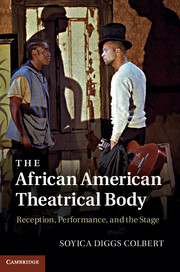Book contents
- Frontmatter
- Contents
- Illustrations
- Acknowledgements
- Overture: rites of reparation
- Chapter 1 Repetition/reproduction: the DNA of black expressive culture
- Chapter 2 Recuperating black diasporic history
- Chapter 3 Reenacting the Harlem Renaissance
- Chapter 4 Resisting shame and offering praise and worship
- Chapter 5 Resisting death: the blues bravado of a ghost
- Chapter 6 Rituals of repair
- Chapter 7 Reconstitution
- Epilogue Black movements
- Notes
- Bibliography
- Index
Chapter 4 - Resisting shame and offering praise and worship
Langston Hughes' Tambourines to Glory
Published online by Cambridge University Press: 05 November 2011
- Frontmatter
- Contents
- Illustrations
- Acknowledgements
- Overture: rites of reparation
- Chapter 1 Repetition/reproduction: the DNA of black expressive culture
- Chapter 2 Recuperating black diasporic history
- Chapter 3 Reenacting the Harlem Renaissance
- Chapter 4 Resisting shame and offering praise and worship
- Chapter 5 Resisting death: the blues bravado of a ghost
- Chapter 6 Rituals of repair
- Chapter 7 Reconstitution
- Epilogue Black movements
- Notes
- Bibliography
- Index
Summary
Essie Belle Johnson, one of the female protagonists of Langston Hughes' Tambourines to Glory, sings “Upon this rock I build my church. The gates of hell shall not prevail” and convenes the first meeting of Tambourine Temple. The meeting takes place on a curb in Harlem “above the gutter.” Essie and Laura, called the Reed sisters “even if [they] ain't no relation,” do not actually occupy a building; Essie's song attracts an audience and thus inaugurates their church (192). Her melodic and soulful singing inspires the crowd as it introduces the tension between secular and spiritual necessity central to the play and fundamental to the African American sermonic tradition. Poverty motivates Essie and Laura to start their church, but as the gospel song Essie and Laura sing suggests, Tambourines to Glory is also interested in mobilizing the double-voiced quality intrinsic to gospel music, which aims toward triumph over material defeat and spiritual death. Therefore, even though the rock is Jesus, the location of the singers establishes the intersecting need for a spiritual and a material foundation.
Situated in Harlem after World War II in the burgeoning years of the modern Civil Rights Movement, Tambourines to Glory deploys the African American sermon, using it as an effacement of race- and class-based shame. In many texts of the period, African American writers communicate the shame associated with poverty. Ubiquitously repeated in Native Son (1940), the definitive quality of Bigger Thomas's existence is shame. Instead of turning anger and pain inward, Tambourines to Glory demonstrates how to deflect intrusive and judgmental gazes. The play provides a sly defense against the visual dismissal Du Bois posits as the source of his double consciousness in the opening pages of The Souls of Black Folk. The ability, however, to anticipate such visual slights comes at a cost. The sermons, often sung in the play, highlight the powerful possibilities and simultaneous costs of sly and deflective African American performance traditions. This chapter analyzes the religious activity Tambourines to Glory depicts as a part of African American worship practices, the cultural customs in Harlem in the wake of World War II and in the midst of the Cold War, and the politics of the flourishing Civil Rights Movement. This modern morality play suggests that the ethos of black Christianity requires a progressive social performance structured by a tradition of reading between the lines.
- Type
- Chapter
- Information
- The African American Theatrical BodyReception, Performance, and the Stage, pp. 123 - 158Publisher: Cambridge University PressPrint publication year: 2011



